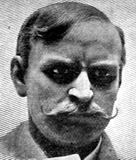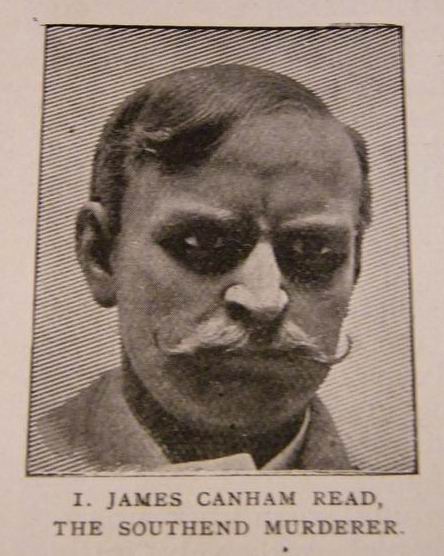On 4th December 1894, James Canham
Read, a middle-aged, married bookkeeper at the London Docks was executed
for the murder of one of his several mistresses, 18 year-old Florence
Dennis. She was found shot in a field at Prittlewell. He had been
arrested after police traced a telegram he had sent to a relative.
James Canham Read 1894
I am grateful to Jeff Bloomfield of London for providing the following details. He also
supplied reference for further study which appear at the end.
James Canham Read (born 1855)
lived at 57 Jamaica Street, Stepney and was a cashier at the Royal
Albert Docks. He was a married man with eight children.
On the surface, he could be very
moralistic. In 1889, during the trial of Florence Maybrick for poisoning
her husband in Liverpool, Read had written a letter to a newspaper,
condemning the sympathy displayed to such a murderess. But for all that
moralism, he did not discuss adultery. For Read was a lothario who
carried on many affairs.
In the same year as the trial of
Mrs Maybrick he had an affair with Mrs Bertha Ayriss and in 1892 he met her
18 year old sister, Florence Dennis.
A quarrel developed between the
two sisters about Read, which led to him apparentlybreaking off
relations. Yet Mrs. Ayriss was sure that Read had visited hersister,
but couldn't prove it. A letter in Read's handwriting turned up in
someclothes of Florence, and Bertha had a firmer basis for believing
Read was in touchwith Florence.
Florence went to Southend to
live with her mother. In the spring of 1894 Florence told her mother she
was pregnant, and that Read was the father. Apparently she had only
recently learned that Read was married. Florence contacted Read, and
asked what he was going to do about her problem.
Read, all this time, was living
in what could only be called a fool's paradise. He had a system of
contacting Florence through third party drop off points under assumed
names. Florence followed his instructions to a point - he thought she
kept what was going on quiet, and that nobody knew about their
connection. In fact, Florence had confided in her mother, and Bertha
knew on her own.
Read may have been planning to
get rid of Florence for awhile, given the care he took to avoid direct
contact as much as possible. He finally told her to meet him at the
village of Prittlewell, near Southend. How he selected this site is not
known, but given the deserted area he chose he must have searched for
awhile. On Monday, June 24, 1894 Florence went to Prittlewell, and was
met by a man. They walked through some woodland park, at dusk. When in
an isolated spot Read asked Florence if she had mentioned that they were
meeting. Knowing what he wanted to hear she said "No". When her back
was turned he shot her in the head.
He hoped to catch a train from
Prittlewell back to London, and missed it. He could not afford to wait
for the next train. To rent a wagon would have been to invite questions
that would lead to his identity. So Read decided to walk the many miles
back to Stepney. It took him all night. In the course of it, he had to
stop several people for directions, and with typical luck he stopped a
smart constable among them. Still he continued walking most of the
night, and got back to his home.
He was at his desk at the Albert
Dock the next morning, when he was told there was a message for him. It
was from Bertha Ayriss, and she wanted to know where Florence was.
Shocked, Read decided to brazen it out, and sent a response denying
seeing Florence for two years. But his nerve was cracked. He robbed the
safe at the Albert Dock and fled.
Another reason for suspecting
that Read was plotting against Florence was that he had another
girlfriend who lived at Mitcham. He had married this woman, so she
thought he was her husband. He arrived there, intending to hide out.
In the meantime he let his beard grow (Read had a mustache and small
sideburns) as a disguise.
Read had contact with his
brother Harry, and the police were able to track him down to that
village. Arrested in the cottage there, he was taken to London to stand
trial for the murder of Florence Dennis. Defended by Alfred Cock, Q.C.,
Read's whole defense was there was no proof he had been seen or in
contact with Florence since 1892, and that he was not at Prittlewell on
the night of the murder. And at this point every strand of the various
pieces of plotting came back to hit Read's defense. People remembered
him dropping off messages for Florence, and being in the vicinity of
Prittlewell, and being on that mad road trip back to London (including
the smart constable). Bertha Ayriss told of what she found in the note
from Read to Florence, and her mother told of what she heard from
Florence.
However Cock did score a point
against Bertha, who had to admit that her relationship with Florence was
ruined by their battling over Read.
Read was found guilty,
protesting his innocence to the end. He was executed in 1894. A nervous
wreck by the time that he went to the gallows, he asked the executioner,
"Will it hurt?" before he found out.
We have to delve back a hundred years to come up with
the likes of James Canham Read.
Jimmy, who variously lived in London, England, and
surrounding towns, had four ladies on the string at the same time.
Admittedly, he was tall, handsome and charming, decided assets if one
plans on making the pursuit of ladies a full-time career.
For starters, there was his wife, who gave Jimmy
eight children. As a result, she was kept busy washing and cleaning. But
she does not enter the saga of her husband's peccadilloes except for the
fact she was his legal wife.
It was in August that Jimmy met Mrs. John Ayriss
quite by accident. He took one look at the well turned mother of four
strapping children and felt a sly biological urge that simply had to be
satisfied. Jimmy pursued Mrs. Ayriss until he caught her.
There was one gnawing inconvenience. Jimmy's salary
as a clerk at the Royal Albert Docks was the not-very-princely sum of
140 pounds per annum. It was hardly enough to keep the original Mrs.
Read and the eight little Reads in cookies and cakes, let alone finance
an affair. Quite possibly Mrs. Ayriss helped defray the cost of their
illicit relationship.
About a month after Jimmy and Mrs. Ayriss commenced
on a regular basis doing what comes naturally, they were strolling on
Clapham Common and bumped into Mrs. Ayriss' younger sister, Florrie. Mrs.
Ayriss introduced Florrie to Jimmy. That was a mistake. Jimmy's eyes
almost popped out of their sockets. Florrie was a rare beauty just
waiting for a gentleman with Jimmy's looks and charm to come along.
Within two weeks, Jimmy and Florrie were lovers.
From the end of 1892 well into May of 1893, Jimmy
bedded down all three women without any of them being the wiser. Nothing
lasts forever. Mrs. Ayriss found out about her darling sister Florrie
and was fit to be tied.
Alas, there was little she could do about her
situation. She had a hubby and four children who had no idea that Mummy
wasn't playing bingo twice a week.
Jimmy never had it so good. One fine day he walked
into a candy store to sample some sweets. The sweet young morsel behind
the counter caught his eye.
Jimmy introduced himself as commercial traveller
Edgar Benson. Miss Kemper was enthralled, intrigued and smitten. Before
you could say hard centre, Jimmy had Miss Kemper pleasantly ensconced in
a little love nest called Rose Cottage in Mitcham. She, of course, had
no way of knowing her Edgar had three other ladies living and loving
under separate roofs.
It is conceivable Jimmy could have maintained his
four arrangements indefinitely. True, the energy expended tended to tire
and was time consuming, but the pleasures involved far outweighed the
inconveniences.
Then it happened. Florrie announced to Jimmy, "I'm
going to have a baby, and it's yours." Jimmy was distraught.
If older sister Mrs. Ayriss found out he had
impregnated darling Florrie, she would be mad as the dickens. Who knows
what she would be capable of doing under such circumstances.
Florrie simply had to go. He formulated a plan and
put it into action on June 24, 1893.
He and Florrie met, ostensibly to discuss their
mutual problem. Florrie didn't quite see the problem. After all, they
could always marry, have the baby and live happily ever after. Of course,
Florrie didn't know about Mrs. Read, Mrs. Ayriss and Miss Kemper. No,
Jimmy had made up his mind to kill her.
He and Florrie held hands as they walked idly along a
path near the village of Prittlewell just north of Southend. At an
opportune moment, Jimmy extracted a revolver from his coat pocket and
without uttering a word shot Florrie in the head, killing her instantly.
He tossed her body over a hedge and then proceeded to put his not so
brilliant plan into action.
Jimmy walked all night until he reached London. At 8
a.m., he washed, shaved and ate a hearty breakfast before calling on a
friend. Jimmy was attempting to establish his presence in London at the
time of the murder. By 10 a.m., he was at his office as usual down at
the Royal Albert Docks.
Jimmy had thought of almost everything, but he didn't
count on his bad nerves. What if his plan didn't deceive anyone?
Surely, after Florrie's body was found, the police
investigation would lead to him. Jimmy panicked. He decided to flee, but
he needed money to travel.
Fortunately, there was plenty of money at hand. Jimmy
opened his employer's safe and scooped up 160 pounds, more than he
earned in an entire year. He dashed off to Rose Cottage and the lovely
Miss Kemper. Remember, she knew Jimmy only as Edgar Benson.
Our boy was planning on giving up his wife and Mrs.
Ayriss to become commercial traveller Edgar Benson forever.
Florrie's body was discovered behind the hedge on the
same day that Jimmy stole the money from the safe. A medical examination
revealed she was pregnant. Her identity was quickly established, as her
sister had reported her missing that morning.
For four days, Jimmy whiled away the time at Rose
Cottage making love to Miss Kemper, but it couldn't last.
The theft at the Royal Albert Docks was discovered.
Jimmy was now a suspect in the robbery as well as in Florrie's murder.
On June 29, persistent Scotland Yard detectives knocked on the front
door of Rose Cottage and took Jimmy into custody.
On Nov. 13, 1893, Jimmy stood trial for Florrie
Dennis' murder. The Crown presented a strong circumstantial case. One
witness, a Mr. Douthwaite, swore he had seen Jimmy and Florrie walking
hand in hand beside the hedge where her body was later found
The distraught Miss Kemper told the court that on the
Monday following the murder, Jimmy had shown up at Rose Cottage and had
insisted she purchase all the newspapers which featured the murder.
The English jury took only 30 minutes to bring in a
guilty verdict. James Canham Read claimed he was innocent to the very
end. He was hanged on Dec. 4, 1893 at Springfield Prison, Chelmsford.
Max Haines murder mistery


